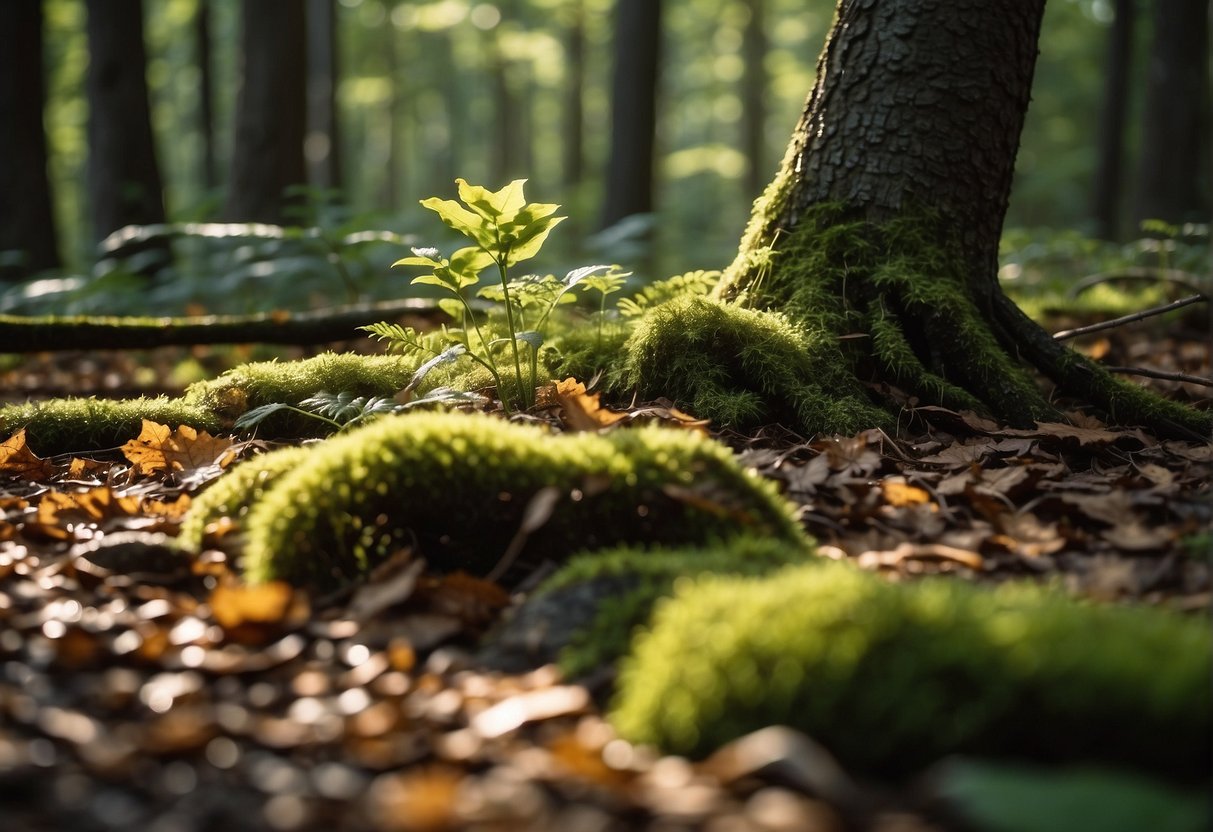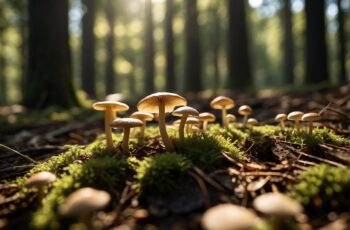Growing morel mushrooms, scientifically known as Morchella, can be a rewarding experience that connects you with the cycles of nature. These distinctive fungi are highly sought after for their delicious taste and elusive nature, often growing in forests and woodlands. As an outdoors enthusiast, you may appreciate the challenge and satisfaction that comes with cultivating these elusive mushrooms.
Understanding the natural habitat of morels is crucial to successful cultivation. These mushrooms thrive in woodland environments, often found in the shelter of deciduous trees such as elms, ashes, and old apple orchards. If you’re considering growing morels in your garden, mimicking their forest conditions is key. This begins with creating a habitat with the right soil composition and moisture levels.
This guide introduces steps to bring the wild essence of morels into your own space, even if you don’t have immediate access to a forest. With the right techniques and some patience, you can enjoy the fruits of your labor with this culinary delicacy. So, roll up your sleeves and prepare to embark on the journey of cultivating morel mushrooms, bringing a piece of the forest’s bounty into your garden.
Understanding Morel Mushrooms
Before we venture into the woods, you need a solid grasp of what morels are all about – from their scientific classification to the essentials of safely identifying these prized fungi.
Taxonomy and Species
Morel mushrooms fall into the genus Morchella, a group known for its distinctive honeycomb-like appearance. These fungi are part of the kingdom Fungi, class Ascomycetes, and order Pezizales, which tells you they belong to a unique and complex family of organisms. There are several morel species, each with its own unique characteristics. For instance, the highly sought-after Morchella esculentoides is one species known for its delectable taste.
- Kingdom: Fungi
- Class: Ascomycetes
- Order: Pezizales
- Genus: Morchella
Morels reproduce through spores, which are released into the air and, with a bit of luck and the right conditions, find a new home where they can germinate and start the lifecycle anew.
Edibility and Identification
When it comes to foraging, the edible mushrooms like true morels are a treasure trove for your palate. They’re delicious when sautéed and are a welcome addition to any outdoor cookout. But beware, the woods can be deceiving with poisonous look-alike mushrooms, such as the false morel. Proper identification is crucial for your safety. True morels have a completely hollow interior from stem to tip when cut vertically, a trademark you should always look for.
- Edible: True Morels (e.g., Morchella esculentoides)
- Poisonous Look-alike: False Morel (e.g., Gyromitra esculenta)
- Identification Tip: Look for a hollow interior – it’s a must.
Remember, identifying morels correctly is not just about a rewarding foray into the forest; it’s about ensuring your foraging adventure doesn’t end in mishap. Always cross-check the mushrooms you find with reliable resources and when in doubt, it’s best to err on the side of caution. Go on, take this knowledge and step confidently into the realm of forestry and fungi.
Creating the Perfect Environment

To successfully cultivate morels, paying attention to the specifics of their growing environment is key. You’ll need the right mix of soil, moisture, light, and temperature to mimic the conditions of a forest floor.
Soil and Substrate Composition
Your morels will flourish in loamy soil that’s rich in organic material. This type of soil closely resembles what these fungi would find in their natural habitat. Aim to maintain a soil pH between 6.8 and 7.2 for optimal growth. Incorporate plenty of leaf litter, compost, and wood chips to create a nurturing base layer that also offers excellent drainage.
Moisture and Humidity Management
Morels demand high humidity levels and consistent moisture without being waterlogged. Strive to keep your soil consistently damp, imitating the moist conditions typically found on the forest floor. Use a fine mist to water, ensuring the environment stays humid to stimulate mycelium growth without over-saturating the soil.
Light and Temperature Conditions
Your morel mushrooms don’t require intense light; filtered, indirect light will do. Place your morels in a location that mimics the light conditions of a forest canopy. Temperature is critical; morels thrive in cooler temperatures, usually between 50°F and 70°F (10°C and 21°C). These conditions encourage the mycelium to develop first and then signal the morels to start fruiting when ready.
Growing Morels Step by Step
Embarking on the journey of cultivating morels, you will engage with the natural cycle from spore to fruiting body. This section outlines how to successfully manage each phase of the morel’s development.
Preparing the Morel Spawn
Start by creating a viable morel spawn, which serves as the seed for your future morel mushrooms. Gather fresh morels and construct a slurry: blend them with a tablespoon of molasses and water. The slurry contains morel spores that will eventually form mycelium after planting. Make sure to use non-chlorinated water to maintain spore viability.
Planting and Caring for Morel Beds
Mushroom beds should be prepared using a mix of grain, wood chips, compost, and peat moss to create an environment conducive to morel growth. Here’s a simplified checklist for the bed preparation:
- Grain: Serve as the initial food source for the mycelium.
- Wood Chips: Simulate the morel’s natural habitat.
- Compost: Enhances the nutrient content of the bed.
- Peat Moss: Helps retain moisture.
For optimal results, sprinkle wood ash in the bed to recreate the alkaline conditions morels favor. Plant your morel spawn in the bed and cover it lightly with soil.
Nurturing and Monitoring Growth
After planting, your role shifts to a caretaker, ensuring the mushroom spawn has the right conditions to form a mycelium network and eventually fruiting bodies. Keep the bed moist but not waterlogged, and maintain a stable temperature, mimicking the conditions found in a forest after a spring rain.
Monitoring the growth involves regular checks for signs of mycelium spreading, a white, web-like formation beneath the soil. With time, morels will start appearing as the fruiting bodies push through the soil’s surface, signaling the arrival of your home-grown forest delicacies: growing morel mushrooms.
Harvest and Post-Harvest Processing
As you venture into the world of morel mushrooms, understanding the nuances of harvesting and caring for your bounty post-harvest is essential. This ensures the integrity of the mushrooms’ nutty flavor and your success in their culinary use.
Harvesting Techniques
When you’re ready to harvest morels, timing, and technique is everything. Gently twist and pull the morel to detach it from its mycelium or cut it at the base with a knife. Be mindful of preserving the mushroom spawn to ensure future growth. Consider searching near apple trees and other deciduous trees, as they create a favorable environment for morels.
Cleaning and Storing Morels
Once harvested, clean your morels carefully. Brush off any debris with a soft brush; avoid washing them directly under water as morels can become soggy. For storage, place them in a paper bag and refrigerate. This method keeps them fresh for a few days. For longer storage, morels can be dried out and rehydrated when needed, preserving their rich, woodsy aroma.
Using Morels in the Kitchen
Morels are known for their nutty flavor, making them a coveted ingredient among cooking enthusiasts. To maximize this flavor, sauté morels lightly in butter. This simple treatment allows the distinctive taste to shine through. Whether you’re foraging or growing them on your own, morels can elevate any meal, from steak to pasta.


